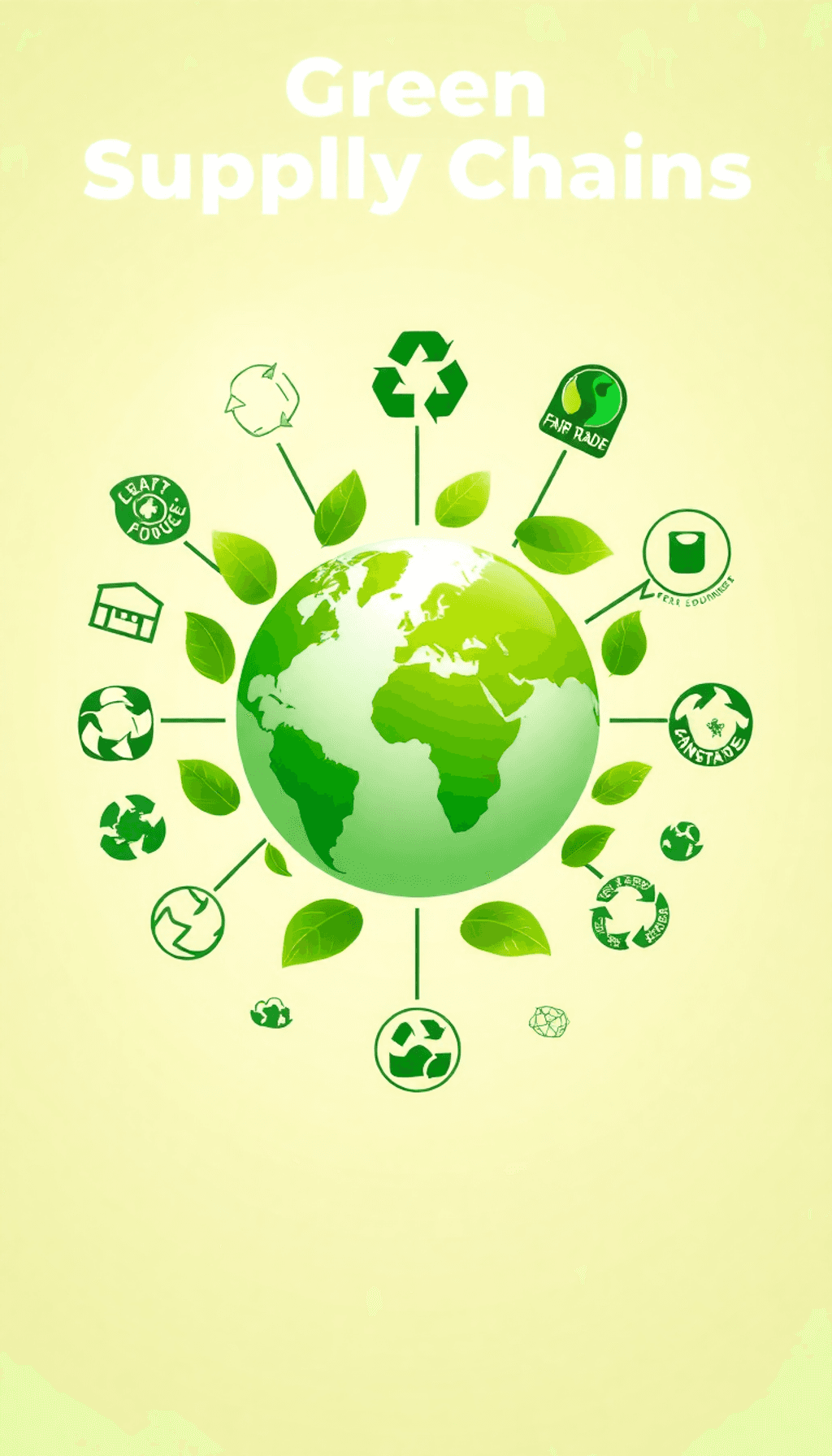Introduction
Sustainability in supply chains has become a critical focus for businesses seeking to minimize their environmental impact and uphold social responsibility. As consumer awareness grows, companies are realizing the importance of integrating sustainable practices into their operations.
Key areas of focus include:
- Reducing carbon footprints by minimizing greenhouse gas emissions
- Implementing ethical sourcing practices to ensure fair labor conditions
- Utilizing recycled materials and environmentally friendly products
By prioritizing these elements, organizations can not only contribute positively to the environment but also enhance their reputation and operational efficiency. For instance, procurement optimization can lead to more sustainable sourcing practices. Additionally, companies can explore avenues like maximizing federal grant funding for nonprofits to support their sustainability initiatives.
Moreover, fostering a sustainable workplace environment goes beyond just the supply chain. It’s also about the well-being of employees. Simple actions like providing break room supplies that boost employee morale can contribute to a more positive work atmosphere.
In sectors such as healthcare, it becomes crucial to have essential PPE for airborne precautions, which not only ensures safety but also reflects a commitment to social responsibility.
Sustainability isn’t just an option; it’s essential for long-term success in today’s market.
Understanding Supply Chain Sustainability
Definition
Supply chain sustainability refers to the management of environmental, social, and economic impacts within supply chains. It focuses on creating value while minimizing harm to the environment and society. This involves integrating sustainable practices throughout the entire supply chain, from sourcing raw materials to delivering products to consumers.
Key Objectives and Benefits
The objectives of implementing supply chain sustainability include:
- Minimizing Environmental Impact: Reducing resource consumption, waste generation, and greenhouse gas emissions.
- Enhancing Social Responsibility: Ensuring fair labor practices and promoting ethical sourcing. This can also involve understanding Diversity, Equity, and Inclusion (DEI) in the workplace.
- Boosting Economic Performance: Achieving cost savings through efficient resource use and sustainable practices. For instance, businesses can adopt frugal living strategies to maximize these savings.
Benefits for businesses encompass:
- Improved Brand Reputation: Companies that adopt sustainable practices often enhance their public image.
- Regulatory Compliance: Adhering to environmental regulations can mitigate legal risks.
- Competitive Advantage: Sustainable supply chains can differentiate a business in crowded markets. This could involve supplier innovation, which is a top trend in achieving this competitive edge.
The significance of embracing sustainability in supply chains extends beyond compliance. It fosters innovation, drives efficiency, and builds resilience against market fluctuations, ultimately contributing to long-term business success. Furthermore, companies can explore various exclusive membership benefits that may provide additional resources or support in their sustainability efforts.
1. Environmental Impact
Efforts to minimize greenhouse gas emissions throughout the supply chain are essential for fostering sustainability. Companies are increasingly adopting strategies such as:
- Energy-efficient logistics: Utilizing electric vehicles or optimizing delivery routes can significantly lower emissions.
- Renewable energy sources: Integrating solar or wind power into operations reduces reliance on fossil fuels.
Implementing sustainable sourcing practices is another critical element. This includes:
- Using recycled materials: Sourcing products made from recycled content helps decrease waste and conserve natural resources.
- Supplier engagement: Collaborating with suppliers who prioritize sustainable practices enhances overall supply chain integrity, a process often linked with supplier relationship management.
Real-world examples highlight successful environmental initiatives:
- Unilever: Achieved a 50% reduction in greenhouse gas emissions per product by enhancing energy efficiency and using renewable energy.
- Patagonia: Utilizes recycled polyester in their clothing lines, showcasing a commitment to sustainable sourcing.
These case studies illustrate how businesses can drive change through innovative practices, reinforcing the importance of environmental responsibility within supply chains. Transitioning to sustainable operations not only benefits the planet but also enhances brand reputation and customer loyalty.
To achieve these goals, companies may need to adopt effective sourcing strategies for hiring top talent, as well as understand the difference between strategic sourcing and category management. For further assistance or inquiries regarding these strategies, please feel free to contact us.
2. Social Responsibility
Social responsibility is a key part of sustainable supply chain programs, making sure that ethical practices are integrated into all operations. Here are the main areas to focus on:
Fair Labor Practices
Organizations must ensure fair labor practices across all stages of the supply chain. This includes providing safe working conditions, paying fair wages, and respecting workers’ rights. By prioritizing these aspects, companies contribute to a healthier workforce and increased productivity.
Ethical Sourcing Standards
It’s crucial to follow ethical sourcing standards when purchasing goods or services. This means choosing suppliers who share your organization’s values, such as using sustainable materials and being transparent in their operations. Ethical sourcing not only builds trust but also enhances your brand’s reputation.
For those looking to kickstart their career in supply chain management, exploring entry-level procurement jobs can provide valuable insights into ethical sourcing practices.
Examples of Commitment
Many organizations demonstrate social responsibility in their supply chains:
- Patagonia: Known for its ethical sourcing practices, Patagonia openly shares information about its suppliers and their labor conditions.
- Starbucks: The company focuses on fair trade coffee sourcing, ensuring that farmers receive just compensation while promoting sustainable farming methods.
Investing in social responsibility not only strengthens relationships with customers and stakeholders but also aligns with global sustainability goals. However, it’s important to note that challenges may arise in the procurement process. In such situations, understanding how to build resilience during crises can be invaluable.
Moreover, the journey of mastering procurement is often a life of learning and transformation, as shown by industry experts like Frank Corris. His experiences highlight how continuous learning and strategic thinking lead to procurement success.
Lastly, businesses often face limitations in resources. In such cases, applying essential tips to succeed with limited resources can optimize processes and leverage networks for better outcomes.
Collaboration and Best Practices for Sustainable Supply Chains
The journey towards sustainability in supply chains requires stakeholder collaboration strategies and industry partnerships. Engaging organizations such as NGOs can significantly enhance the development of sustainable practices. Their expertise helps identify critical areas for improvement and promotes shared goals among various stakeholders.
Key Strategies for Collaboration:
- Mapping Materials: Creating a comprehensive map of materials used in sourcing initiatives allows organizations to identify opportunities for sustainable alternatives. This collaborative approach encourages transparency and fosters trust among partners.
- Shared Best Practices: Organizations can drive collective progress by sharing successful strategies. Regular workshops, forums, or online platforms enable companies to exchange insights on sustainability challenges and solutions.
- Cross-Industry Partnerships: Collaborating with businesses across different sectors can lead to innovative solutions. By leveraging diverse perspectives, companies can tackle sustainability issues more effectively. For instance, purchasing groups versus group purchasing organizations is a prime example of how collaboration can be structured to achieve better procurement outcomes.
Examples of successful partnerships highlight the impact of collaboration on sustainability outcomes. Companies that actively engage with their supply chain partners not only enhance their sustainability efforts but also create a more resilient network capable of adapting to future challenges.
Leveraging Technology and Data Analytics for Supply Chain Sustainability
Technology and data analytics are crucial in achieving sustainable supply chains. Digital tools that measure progress empower businesses to effectively monitor their sustainability efforts. These tools can track important metrics like carbon emissions, waste management, and resource utilization, enabling organizations to make informed decisions based on data.
Key Techniques:
1. Data Analytics for Enhanced Visibility
Advanced data analytics techniques improve visibility across complex supply networks. This visibility allows companies to identify inefficiencies, monitor supplier performance, and ensure they meet sustainability goals. For example, by maximizing supplier performance, businesses can maintain quality and reliability while also achieving sustainability targets.
2. Resource Tracking
Technology-driven solutions enable accurate tracking of resource usage. By using IoT devices and real-time monitoring systems, businesses can analyze consumption patterns and optimize their operations accordingly. This approach also ties into leveraging significant cost reduction through collective spending, which can further enhance sustainability efforts.
3. Supplier Conditions Monitoring
Understanding the conditions of suppliers is crucial for sustainable sourcing. Technology enables organizations to gather insights about labor practices, environmental compliance, and ethical sourcing standards. This emphasizes the importance of transparent communication with suppliers, which is essential for building trust and fostering business growth.
By implementing these digital solutions, supply chains become more transparent. Organizations can compare their performance against industry standards, leading to continuous improvement in sustainability initiatives. The integration of technology not only streamlines processes but also aligns business operations with broader environmental goals.
Overcoming Challenges in Implementing Sustainability Programs
Implementing sustainability programs within supply chains presents several challenges. Key obstacles include:
- Upfront Costs: Many organizations encounter significant upfront costs associated with sustainability efforts. Investments in new technologies, sustainable materials, and employee training can deter companies from initiating these programs. Smaller firms often feel these financial burdens more acutely, making it crucial to explore funding options and incentives available for sustainable practices.
- Measuring ROI: Companies frequently face difficulties in measuring return on investment (ROI) on sustainability initiatives. Quantifying benefits such as reduced waste, energy savings, and improved brand reputation can be complex. Without clear metrics, organizations may struggle to justify ongoing investments in sustainability. Developing comprehensive frameworks for evaluation is essential for demonstrating long-term value.
- Cultural Resistance: Resistance to change can hinder the adoption of sustainable practices. Employees accustomed to traditional methods may require time and support to adapt. Effective communication and employee engagement strategies are vital for fostering a culture that embraces sustainability.
Navigating these challenges requires a strategic approach focused on education, collaboration, and transparency throughout the supply chain.
Long-term Goals and Future Directions for Sustainable Supply Chains
Setting ambitious long-term goals is essential for achieving efficient resource utilization and advancing decarbonization efforts. Organizations can adopt specific targets such as:
1. Resource Utilization Efficiency Targets
Establish metrics to optimize the use of materials, energy, and water across the supply chain. This could involve implementing circular economy practices, such as reusing and recycling materials.
2. Decarbonization Efforts
Develop plans to significantly reduce greenhouse gas emissions. Strategies may include transitioning to renewable energy sources and enhancing energy efficiency in logistics and production processes.
Risk reduction becomes a significant benefit of integrating sustainable practices into supply chains. By focusing on sustainability, businesses can:
- Mitigate potential regulatory risks associated with environmental compliance.
- Strengthen brand reputation through enhanced corporate social responsibility.
- Build resilience against supply chain disruptions by diversifying suppliers who prioritize sustainable practices.
As companies commit to these long-term goals, they not only contribute positively to the environment but also position themselves favorably within increasingly eco-conscious markets. Investing in sustainability now creates a foundation for enduring success, ensuring that organizations remain competitive while fostering a healthier planet.
Case Study: Hubzone Depot LLC’s Approach to Sustainability
Hubzone Depot LLC exemplifies a strong commitment to sustainability through its certifications and compliance efforts:
- HUBZone Compliance Certification: This process ensures that Hubzone Depot contributes to economic revitalization in designated areas, enhancing access to federal contracting opportunities.
- Woman-Owned Business Enterprise (WBE) Certification: This certification highlights the company’s dedication to diversity and inclusion within the supply chain.
The procurement services offered by Hubzone Depot LLC play a crucial role in advancing broader industry-wide sustainability goals. By focusing on:
- Sustainable sourcing practices
- Competitive pricing for high-quality products
- Streamlined purchasing processes, including [tail spend management](https://hubzonedepot.com/tag/tail-spend-management)
Hubzone Depot not only aids organizations in achieving their sustainability objectives but also demonstrates how ethical business practices can drive positive environmental impact.
Client testimonials further emphasize the effectiveness of Hubzone Depot’s approach. Feedback reflects:
- Exceptional service quality
- Significant cost savings, averaging over 20%
- A strong commitment towards sustainable practices
These elements showcase how Hubzone Depot LLC integrates sustainability into its core operations, reinforcing its position as a leader in responsible supply chain management. The company also provides valuable insights into the procurement engineer salary trends for 2025, which can help prepare aspiring professionals for a promising career path. For those managing a one-person procurement function, Hubzone Depot offers strategic solutions for cost efficiency and supplier management. Moreover, understanding certain procurement terms can enhance communication about procurement’s value within an organization.
Additionally, the company’s commitment to supplier diversity further strengthens its sustainability efforts by promoting inclusivity and equity within the procurement process.
Conclusion
Embracing sustainability is essential in today’s business landscape. Organizations must prioritize sustainable practices across their supply chains to remain competitive and responsible. Key benefits include:
- Enhanced Reputation: Companies demonstrating commitment to sustainability attract environmentally conscious consumers.
- Cost Savings: Efficient resource use often leads to reduced operational costs, benefiting the bottom line.
- Regulatory Compliance: Adopting sustainable practices helps businesses comply with evolving regulations.
Supply chain sustainability programs not only contribute to environmental stewardship but also drive social responsibility. By integrating these principles, organizations can foster innovation and resilience, positioning themselves for long-term success. The collective effort towards sustainable supply chains is imperative for creating a better future for both businesses and the planet. Prioritizing these initiatives ensures that your organization meets the expectations of stakeholders while making a positive impact on society and the environment.
FAQs (Frequently Asked Questions)
What is supply chain sustainability?
Supply chain sustainability refers to the comprehensive approach of managing supply chains in a way that minimizes environmental impact, promotes social responsibility, and ensures economic viability. It encompasses practices aimed at reducing greenhouse gas emissions, ensuring fair labor practices, and implementing ethical sourcing standards.
Why is it important to focus on environmental impact in supply chains?
Focusing on environmental impact is crucial as it helps companies minimize greenhouse gas emissions and adopt sustainable sourcing practices. This not only benefits the environment but also enhances brand reputation and compliance with regulatory requirements. Successful case studies demonstrate that environmentally conscious initiatives can lead to significant operational efficiencies and cost savings.
How do organizations ensure social responsibility within their supply chains?
Organizations ensure social responsibility by upholding fair labor practices at every stage of the supply chain and adhering to ethical sourcing standards. This involves rigorous monitoring of suppliers, promoting transparency, and engaging in supply chain sustainability programs that prioritize human rights and community welfare.
What role does technology play in achieving supply chain sustainability?
Technology plays a vital role in achieving supply chain sustainability by providing digital tools for measuring progress and utilizing data analytics for enhanced visibility. These technologies enable organizations to track resource use, monitor supplier conditions, and identify areas for improvement within complex supply networks.
What are some common challenges faced when implementing sustainability programs?
Common challenges include upfront costs associated with adopting sustainable initiatives, difficulties in measuring return on investment (ROI), and navigating the complexities of integrating sustainability into existing supply chain operations. Organizations must develop strategies to address these barriers while pursuing their sustainability goals.
How can companies set long-term goals for sustainable supply chains?
Companies can set long-term goals for sustainable supply chains by establishing targets for efficient resource utilization and decarbonization efforts. They should also focus on risk reduction through the adoption of sustainable practices over time, ensuring that their strategies align with broader industry trends and regulatory expectations.





